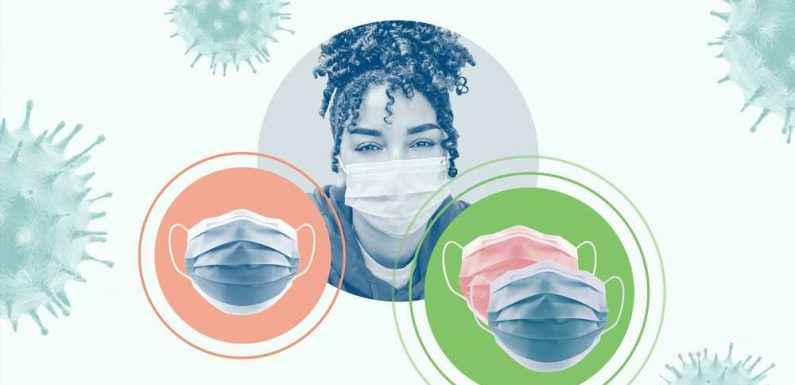
The case for wearing a face mask to protect against COVID-19 is strong. According to the latest scientific brief from the Centers for Disease Control and Prevention (CDC), face coverings can reduce the risk of coronavirus infection by more than 70%. But if wearing one face mask offers solid protection, does wearing two masks at the same time work even better? Some people have started "double-masking" to increase their odds of staying COVID-free, and the trend made us wonder what the science says. Here's what experts told us.
Wearing two masks: what experts know right now
At this time, very little scientific data points to any benefits or drawbacks of wearing more than one face mask, Scott Segal, MD, Thomas H. Irving professor and chair of anesthesiology at Wake Forest Baptist Health in Winston-Salem, North Carolina, tells Health. (Dr. Segal conducted tests on a range of cloth materials to see how effective they would be as face masks for a 2020 study in partnership with the Wake Forest Institute for Regenerative Medicine.)
One small study directly addresses the benefit of wearing two masks simultaneously, but it hasn't yet been peer-reviewed (which means the results shouldn't be used to guide doctors and clinicians yet). In that study, the researchers found that a two-mask "sandwich" might prove better when a higher-functioning mask isn't available.
"Wearing two masks might be a reasonable idea if the filtration capability of the masks isn't very strong," says Dr. Segal.
Most studies, including Dr. Segal's, have found that multiple layers of cloth filter viral particles better than one single layer, and two layers of high-quality cloth with a tight weave perform best. "With poorer quality materials, more layers may perform better," Dr. Segal says.
Wearing two masks works in the same way—and combining two layers of relatively inefficient material may perform better together than a single poor quality mask. In addition, wearing a relatively loose fitting surgical or other medical type mask with a tightly fitting cloth mask over it may create a better mask "sandwich," Dr. Segal suggests.
Infectious disease expert Amesh Adalja, MD, senior scholar at the Johns Hopkins University Center for Health Security in Maryland, agrees that the effectiveness of wearing two face masks depends on the mask material. "Where you need to wear two masks depends on the quality of the mask," Dr. Adalja tells Health. "It depends on the fit of the mask and how well it serves as a barrier."
What about wearing a separate filter inside the mask?
Another mask trend has some people inserting a filtering material inside their mask, such as a piece of an air conditioning filter or coffee filter. As with double-masking, doing this might give you more protection if your mask doesn't fit well or the material quality is poor. If the mask is otherwise poorly functioning, this may improve its capability significantly, Dr. Segal says.
"There is evidence that just as a coffee filter is an effective strain in limiting small coffee grains from seeping through, it might also filter some COVID-19 droplets," Leonard Krilov, MD, chief of Pediatric Infectious Disease at NYU Langone Hospital–Long Island, tells Health. But Dr. Krilov adds that a coffee filter inside a mask could be uncomfortable and make it harder to breathe—which would cause the wearer to tug at the mask and not keep it on appropriately. "Best to leave the coffee filter for its intended purpose of making a good cup of joe," he says.
Bottom line on double-masking
The issue comes down to quality vs. quantity: If a well-fitting, effective face mask isn't available, then two lesser-quality face masks worn together might improve protection.
However, if wearing two masks makes it difficult to breathe, ditch one of them. "No mask works if you can't comfortably wear it, and doubling up masks to the point that you can't breathe easily through them may make you either take them off or breathe around them, disabling the filtration effect," Dr. Segal says.
"It's a double-edged sword," Dr. Krilov agrees. "An extra barrier may sound like a good idea, but that extra layer may make it more difficult to breathe, making it more likely that you pull on the mask to breathe better and not keep it adequately in place."
Double-masking or adding a filtering material might be the latest pandemic trends, but you don't need to jump on them just because you see other people doing it. "The consensus is that an appropriate mask is either a surgical mask or a cloth mask that has two layers," Dr. Krilov says.
Here's a quick refresher on the best face masks: The CDC recommends choosing a mask that has two or more layers of washable, breathable fabric. It must completely cover your nose and mouth and fit snugly against the sides of your face (no gaps). Don't wear a mask that's made of vinyl or another fabric that makes it difficult to breathe. The CDC also advises against a mask with exhalation valves or vents, as these let virus particles escape.
The information in this story is accurate as of press time. However, as the situation surrounding COVID-19 continues to evolve, it's possible that some data have changed since publication. While Health is trying to keep our stories as up-to-date as possible, we also encourage readers to stay informed on news and recommendations for their own communities by using the CDC, WHO, and their local public health department as resources.
This story originally appeared on health.com
Source: Read Full Article









